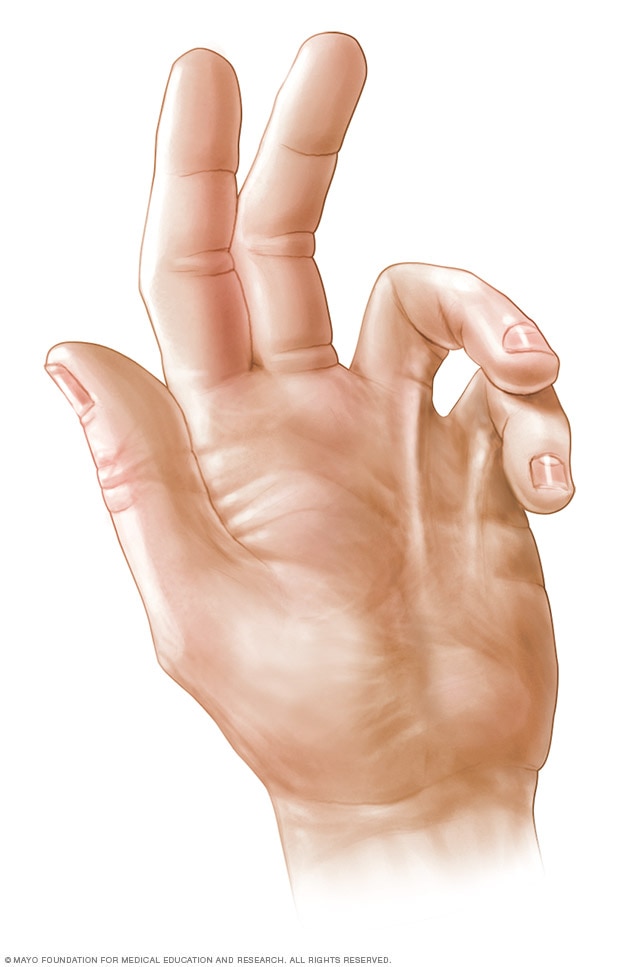
Dupuytrens Contracture
AN OVERVIEW

Dupuytren’s contracture (DC) is a deformity of the hand due to an overproduction of collagen that develops slowly over time. It occurs when nodules and cords of fibrous tissue form in the space between the tendons of the fingers and the skin of the palm. This space is known as fascia (a thin layer of tissue enclosing the muscles).
As the nodules and cords increase in size, they cause one or more of the fingers to curl and become fixated in a bent position. As a result, certain tasks, such as putting on gloves or shaking hands, become difficult.
DC typically affects the ring and pinky fingers and most severely occurs in older men of Northern European descent (English, Irish, Scottish, French or Dutch). Other risk factors may include:
- A family history of the condition
- Diabetes
- Use of tobacco and alcohol products
There is no known cause for this condition. Furthermore, it is not associated with trauma to the hand or heavy hand use.
SYMPTOMS OF DUPUYTREN’S CONTRACTURE
The symptoms of DC happen gradually over the course of many years and generally begin as a thickening of the skin on the palm of the hand. However, as the diseases progresses:
- The skin of the palm may also become dimpled or puckered in appearance
- Nodules may form under the skin that are tender to the touch
- The cords of tissue that form under the skin can extend through the length of the fingers, pulling them inward toward the palm. This finger curvature can range from mild to severe
- Pain, aching and itching may appear
TREATMENTS FOR DUPUYTREN’S CONTRACTURE
Treatment for DC is dependent upon how the condition progresses. In some cases, the condition does not progress past the formation of tiny nodules in the hand. Should other symptoms appear, however, there are surgical and non-surgical treatment options available to remove or break down larger collagen cords.
NON-SURGICAL TREATMENTS
Non-surgical treatment options are ideal for mild to moderate DC when there is no risk of nerve or tendon damage. Treatments include:
- Needling (also known as needle aponeurotomy or percutaneous needle fasciotomy): For this technique, a needle is inserted through the skin to puncture and break the cord of tissue contracting the finger. It can be performed on several fingers at the same time with no incision and little physical therapy afterwards.
- Steroid injections: Anti-inflammatory corticosteroids are injected into nodules that have become painful. They may also aid in reducing the progression of the contracture. However, several injections may be required for a lasting effect.
- XIAFLEX® injections: XIAFLEX is an FDA-approved medication made from a mixture of natural proteins known as collagenase to break down the excess collagen in the hand by injecting it directly into the cord. XIAFLEX is usually given in a treatment cycle of up to two injections, four weeks apart.
SURGICAL TREATMENTS
If the curvature of the finger is severe, surgery may be the only option available to provide DC relief. Surgical treatments include:
- Partial palmar fasciectomy: A partial palmar fasciectomy is the most common surgical procedure for DC in which the cord of tissue is removed from the palm and the affected fingers. The number of incisions for this procedure is dependent upon the surgeon’s approach.
- Total palmar fasciectomy: This procedure cuts the cords at the palm and involves the removal of the entire fascia in the hand. This is done whether or not DC affects the fascia in an attempt to keep the disease from reoccurring.
For both types of surgery, the procedural details are the same. After being placed under anesthesia (or given a regional/local injection in which the patient remains awake), the arm and hand are washed in antimicrobial solution and a tourniquet is put in place.
During the procedure, the hand surgeon makes several incisions and identifies the arteries and nerves in the hand to prevent damage. The cord and nodule tissue is then removed. In some cases, skin of the palm may be removed and replaced with grafts (thin pieces of skin taken from a different part of the body).
Depending on the severity of the contracture and the number of fingers affected, surgery may take several hours but may be performed on an outpatient basis. Complete treatment of the condition is dependent on which joints are affected, the severity of the contracture and how long the contracture has been present.


